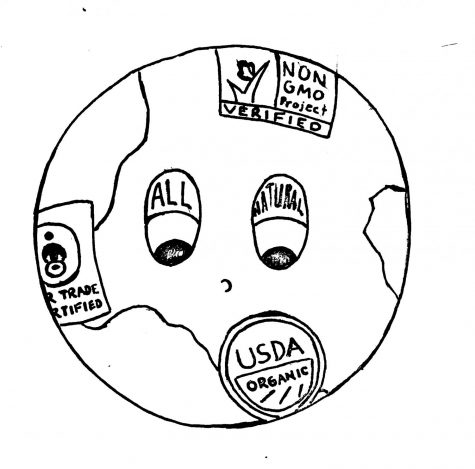Global Warning: We don’t want to ‘label it’
April 12, 2021
“Organic.” “Non-GMO.” “All-natural.” After years of wandering through the grocery store and seeing these stickers piled up on food products, my curiosity got the best of me. What is the difference between organic and made with organic ingredients? How is cage-free any different from free-range? Does buying items with these labels truly make a difference?
According to Ecolabel Index, a website that provides descriptions of environmental food labels, almost 150 different stickers and certifications are allowed on produce and packaging alone. Few labels serve the same purpose, and their lack of uniformity just confuses everyone.
The moral dilemma that occurs while browsing the egg section in a market is one of the best examples of this. While shoppers hopefully opt for meat and poultry items with either a “cage-free,” “free-range” or “pasture-raised” marker, the specifications behind each can misdirect even the best efforts to be animal-friendly. “Cage-free” ensures that chickens can move around in indoor houses, with access to fresh food and water. Yet this label fails to inform consumers that there is no minimum space requirement or allowance to roam outside of these areas.  “Free-range” gives the hens the same conditions as “cage-free” but ensures they have outdoor access, but not necessarily in natural conditions that provide sun exposure. Products labeled “pasture-raised” provide the best living conditions for meat — this dictates that the animals must be placed in a pasture environment for at least six hours a day. This information is rarely offered on the egg cartons, creating a lack of transparency that feeds into the economic profit of food corporations as consumers play label roulette.
“Free-range” gives the hens the same conditions as “cage-free” but ensures they have outdoor access, but not necessarily in natural conditions that provide sun exposure. Products labeled “pasture-raised” provide the best living conditions for meat — this dictates that the animals must be placed in a pasture environment for at least six hours a day. This information is rarely offered on the egg cartons, creating a lack of transparency that feeds into the economic profit of food corporations as consumers play label roulette.
This hierarchy of animal product labels is mimicked by the sustainability claims on produce and other groceries. From a consumer perspective, “organic” might be a fruit sticker, an elevated price point or even a peak environmental health symbol. The United States Department of Agriculture (USDA) defines organic as a food production method “without the use of synthetic inputs,” including fertilizers, pesticides, and genetically-modified organisms (GMOs). It also emphasizes environmentally sustainable practices. Few other stamps undergo the same rigorous certification process required for a USDA certification, but they still advertise similar benefits on many of the products we see.
More labels equate to more specifications on a foodstuff item, but the lack of a uniform system brings too many unspecified, sometimes unregulated, third-party organizations into the assortment of products. Recognizable certifications such as the rectangular “Non-GMO Project,” “Rainforest Alliance” and “Fair Trade Certified” all ensure a lack of genetically modified ingredients and some worker protections (which the USDA label does not). However, they all serve specific purposes that do not include regulations on chemicals, pesticides or synthetic fertilizers that cause just as much controversy as the formidable GMO.
Without extensive knowledge concerning the multitude of food production labels, consumer confusion often leads to misguided purchases or a disregard for sustainability claims entirely. Having a concrete system that verifies products at their different levels or forms of sustainability under one transparent organization would spark more environmentally-minded purchases. But until labeling becomes more organized, researching brands and certifications is decisively a better alternative to picking the greenest-looking one.
Look for USDA-approved labels for additive-free products that promote the best environmental treatment and “Food Justice,” “Fair Trade” and “Fair for Life” stickers that protect worker rights. Since many certifications fall into just one of these categories or don’t specify any overlap, check websites like FoodPrint to understand their meanings and impact. It is time to put a label on our relationship with the environment.






